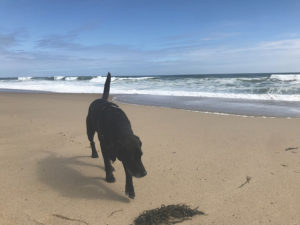
As a veterinarian on Cape Cod in the summer, I sometimes feel as if I am spying on visitors who are probably here for a short time and trying to get as much beach time in as possible. Sitting on the beach, you look around and see them. They are the ones with the lobster-red skin. You hope they drink a lot of water and have an aloe plant in their hotel room.
In the veterinary world, we see these same “can’t get enough of the beach, don’t care that I am overdoing it” folks when they bring their dogs in suffering from sand impaction, usually on a Monday morning. That’s because everything happens in our world on Monday mornings, but also because the dogs usually arrive with their people on Saturday and spend the day at the beach on Sunday.
While his human owners get third-degree burns, the dog might be playing ball in the sand for the first time, picking up a mouthful of sand with each retrieval of the ball. Or perhaps he’s chowing down on sand flavored by a dead fish or finding where someone had a beach fire and dropped a few s’mores.
Usually these dogs come to us with their owners saying their pets did not want to eat the night before, vomited, or just didn’t feel great. (Unless the dog is a Labrador, in which case he was sick, but kept right on eating.)
We palpate the abdomen, where you can feel the sand in the intestines. This can be exciting. It feels like a sausage casing filled with sand and jelly. On a rectal exam your vet will also usually be able to feel sand. Radiographs will show segments of the intestinal tract filled with bright white sand, which is actually quite a fun X-ray to evaluate.
The good news is, sand impaction typically has a good prognosis. With supportive care and, most important, rehydration, dogs improve very quickly. Rarely do they need to have surgery for this type of impaction, and most dogs that need extensive supportive care have other underlying health conditions compromising their digestive tracts.
For caregivers of the dog, one of the tougher parts of this ordeal is that we usually recommend checking the dog’s stool to see what is passing through — to make sure the sand is clearing. Depending on a person’s constitution, this can be a challenging task, especially when we ask for updates.
Summertime brings other animal eating adventures. Dogs will try to eat things attached to a fish hook (this ends in needing sedation to cut the fish hook out of their mouths). Corn on the cob is a classic summer treat, but if the cob is not properly disposed of and a dog gets hold of it, it almost always needs to be surgically removed from the dog’s intestine. In our family, we treat corn cobs the way a surgeon treats gauze pads: we count them before eating and after, to make sure none were lost in the patient.
Salt water toxicity is a serious concern. These are the dogs that play at the beach all day, drinking salt water with no other source of water for hydration. They typically have fun for hours, but once the car is packed and everyone is headed home, they have a kind of seizure. If treated very quickly and correctly rehydrated, these dogs can do well. If not treated within hours, the prognosis becomes more complicated.
Cats, as always, are different from dogs. We see fewer summertime ingestion issues, especially in our indoor cats. Their summertime hobbies are similar to winter hobbies and include playing with and potentially ingesting dental floss, strings, hair ties, and plastic — all potential problems. When asked their opinion of corn cobs, most cats roll their eyes and walk away.
Sadie Hutchings, DVM, practices at the Herring Cove Animal Hospital in Provincetown.



